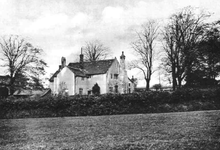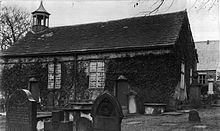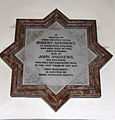- Manor of Rivington
-
The Manor of Rivington was a medieval manor estate in Rivington, Lancashire, England. Before 1212 the Pilkington family owned six oxgangs of land. Over time it became separated in moieties and by the 16th century the Pilkingtons of Rivington Hall owned a 5/8 share. In 1605 the Lathoms of Irlam owned a quarter share and the Shaws 1/8. There were legal disputes regarding the will of Robert Pilkington who died 17 November 1605 and in 1611 the Rivington Hall estate was sold to the Breres with a mortgage from the Levers of Little Lever. Katharine Pilkington, retained New Hall and associated land.
The Cromptons sold Rivington Hall and their interest in the manor to William Lever in 1900. Most of Lever's estate was compulsorily purchased by Liverpool Corporation, apart from 45 acres (18 ha) which he retained for his residence and private gardens. After Lever's death in 1925 his remaining estate was sold to the McGees.
Contents
Pilkington of Rivington Hall
The Pilkingtons were step brothers of the Rivingtons who were recorded in a grant of land in 1202.[1][2] In 1212 Alexander de Pilkington held of King John, in thanage, six oxgangs of land at a rent of 10s but the land was divided.[3] The Anglo Saxon term thanage possibly indicates the manor may predate the Domesday Book.
Rivington was held by the Pilkington family until 1290 when Sir Alexander de Pilkington (1225–1291) of Pilkington gave his lands at Rivington to his second son, Richard as a gift on his marriage to Ellen, daughter of William de Anderton, of Rumworth and Anderton.[4] From then until 1605 Rivington was held by the junior branch of the Pilkington family. This change of ownership saved the Rivington estate after the Battle of Bosworth Field in 1489 when Sir Thomas Pilkington of the senior branch lost his estates by Royal Attainder.
In 1324, Roger de Pilkington held seven-eighths of the manor at a rent of 8s. 9d, while Richard de Hulton held the other eighth for 1s. 3d. p.a.[3] In an account of the borders of Rivington, Ferneley or New Hall was mentioned in a grant from Robert Pilkington to his son, John and Joan De Heton on their marriage in 1336,[5] and as a wedding gift from Dame Margaret Pilkington in 1476.[5]
The best known of the Rivington branch was James Pilkington, born in about 1518, the son of Richard Pilkington and Alice Asshawe. He was the first Protestant Bishop of Durham in 1560 and founded Rivington School in 1566. Robert the Bishops grandfather died at Rivington in 1508 having been Lord of the manor for more than 30 years.[6]
The division of the manor was illustrated at the enclosure of the manorial waste land in 1536, out of 20 acres (0.081 km2) of waste land, Richard Pilkington enclosed 13 acres (5.3 ha), James Shaw 3 acres (1.2 ha), and George Lathom 4 acres (1.6 ha).[7] Litigation about the manor wastes was frequent for the next eight decades.[8]
On August 1, 1544 Richard Pilkington executed a transfer of the Rivington estate to trustees for his lifetime and bound the inheritance of the Manor to benefit his sons and his male heirs.[9] On the same day he gave New Hall as a wedding gift to his eldest son George who was born 1506.[9] On the death of Richard Pilkington in 1551, the Manor passed to George but it was burdened by litigation arising out of the enclosure of the wastes.[9] In 1552 George gave New Hall to his mother, Alice, for her lifetime.[9]
George Pilkington died in 1597 and his eldest son, Robert, inherited a manor burdened by debt from litigation. Robert's efforts to enclose the waste lands at Rivington made matters worse. By 1601 Robert had risked the estate by using it as surety for a debt of £250 to William Bispham, of London.[10] Robert defaulted in July 1601, and Rivington and other lands were passed William Bisham until the debt was settled.[11]
On 17 January 1604, as his fortunes declined further, Robert Pilkington agreed a 300 year lease of the manor to James Anderton of Lostock, having made payment to his brother James to obtain his agreement.[12] Robert Pilkington died aged 45 in November 1605 without a male heir, having made his will on the previous day. After his death there was much litigation.
Robert left 25 marks (£16-13-4d) per year to his brother James on condition he did not contest the will to which he had annexed a schedule of his debts. At the inquisition post mortem of Robert Pilkington in 1610, it was stated that, on 6 July 1601 he was seized of the manor of Rivington held of the Duchy of Lancaster.[13]
After Robert's death, his executors, including Katharine Pilkington, aided by Christian Anderton of Horwich, straightened Robert's affairs and, on 30 March 1611, agreed the sale of the Rivington Hall estate to Robert Lever and Thomas Breres, who took on all Robert Pilkington's liabilities, for £1730 in exchange for an annual payment or rent charge to James during his lifetime. Within this sale agreement, "except and always foreprised out of the grant",[14] was a house called New Hall and several fields for the benefit of Katherine Pilkington.[15] On a scrap of paper dated 1620 James sold the benefits of the rent charge from the sale of the Rivington Hall estate and any claim upon the property to Robert Lever and Thomas Breres' widow, Ellen.[12]
Lathom of Irlam
In 1347 Roger de Westleigh of Irlam, Emma his wife, and Adam de Birkhead of Wigan claimed a fourth part of two messuages in Rivington against Robert de Rivington, Richard his son, and others.[3] Three years earlier, their son Roger, had made a settlement of the fifth part of the manor of Rivington in favour of their son Richard.[3] In 1640, after the death of Edmund Lathom, the inquisition stated George, the deceased's grandfather, held a quarter of Rivington manor of the Crown and had made a settlement in 1570.[3] George Lathom of Huyton and his wife Elizabeth were engaged in legal action with Richard Pilkington and others in 1549 and 1550, regarding Moldesfield and land in Rivington. Hyefurth House at Deane Head was part of the Lathom estate and the legal action continued until 1614 when Thomas, son of George Lathom, was granted 50 acres (20 ha) in settlement.[16] In 1683 this land was sold by Thomas Lathom of Irelom in association with Thomas Ashurst of Ashurst and Ralph Egerton of Turton, to John Bradley of Rivington for £120, and included messuages, closes and parcels of land in Rivington and 50 acres (0.20 km2; 0.08 sq mi) moiety of waste ground.[17] Bradley's Farmhouse is a listed building.
Shaw of Rivington, Heath Charnock and Anglezarke
John Shaw married Elizabeth Haydock of High Bullough in Anglezarke, he was a defendant in litigation in 1507, 1528, and 1545 relating to the eighth part of the manor originally held by the Hultons.[3] His grandson, John, married Katherine, sister of Bishop James Pilkington. Robert, son of Thomas Shaw, made a settlement of the eighth part of the manor and other lands in 1606.[3] The Shaw portion was sold to John Risley in 1656 to raise funds for recovery from the English Civil War. Peter Shaw Junior bought back the estate in 1663, selling it some time later and buying it back from John Breres in 1671.[18]
Peter Shaw and his son, Thomas, were in debt at the beginning of the 18th century and sold their estate to Hugh Willoughby, 12th Baron Willoughby of Parham. The estate passed to the 15th Baron. In 1765 on the death of Lord Willoughby the estate passed to his sisters, Elizabeth Shaw and Helena Roscoe.[18] Some land in Rivington and Anglezarke was sold. Elizabeth Shaw died in 1787.
Breres of Rivington Hall
In the inquisition post mortem of Robert Pilkington in 1610, it was stated the Reverend John John Breres, a Presbyterian preacher at Rivington Unitarian Chapel, had bought 3 messuages, 1 cottage, 4 gardens, 4 orchards, and land in August 1603 of which Robert Pilkington was seized in July 1601. The remainder of the Rivington Hall estate was sold to Robert Lever and Thomas Breres, brother of John, on 30 March 1611. In 1667, John Breres mentioned in his will that he had mortgaged his interest in Rivington Old Hall, after the death of his uncle Thomas Breres in 1617, to Rev. James Pilkington of Heaton Rhodes, his wife's uncle, and William Pilkington of Wigan, his father in law. William Breres and his wife Martha Gill lived at the Old Hall. He died in 1723 and the estate passed to their son John who sold it in 1729 to John Andrews who had inherited a share from the Levers.[19]
Lever of Little Lever
Robert Lever of Little Lever near Bolton bought the estate with Thomas Breres in 1611, having bought the outstanding claims and mortgages. He died in 1620, having given his part of the Rivington estate to his youngest son, Robert, a London merchant, in 1617. The Levers were descendants of the Pilkingtons [20] Robert never married and his manor passed to his nephew, another Robert, son of his brother James. Robert Lever had a daughter, Jane, who married John Andrews of Little Lever, near Bolton in 1648.
Andrews of Rivington Hall
In 1648 Jane Lever married John Andrews of Little Lever Hall, a captain in the Roundhead army during the time of the Commonwealth.[21] John Andrews died in 1678.[22] Jane Andrews inherited the estate from her father, Robert Lever who died aged 80 in 1688. The share of the estate passed to her son, John Andrews who married Anne Mort of Wharton Hall, Little Hulton in 1682. Their son, the third John Andrews, born in 1684, married Abigail Crook of Abram.[21] In 1729 he purchased the Breres' share of the estate making him sole owner of the Rivington Hall estate.[23] John Andrews died without a male heir in 1743.
On the death of John Andrews the estate passed to his daughter Abigail who married Joseph Wilson of Bolton. Joseph Wilson died in 1765 and the estate reverted to the line of John Andrews' second son, Robert who married Hannah Crompton in 1712. Their son Joseph Andrews was born in 1715.[24] Robert Andrews died in 1793 and the manor passed to his son, Robert, who died unmarried in 1858. The manor next passed to his brother, John, who died childless in 1865 and finally to his sister, Hannah Maria Andrews who married Robert Fletcher of Liverpool. Their daughter Lucy married Woodhouse Crompton in 1834.
William Hesketh Lever
In 1900, the Cromptons sold their interest in the manor including the hall to William Lever,[3] founder of Lever Brothers, who became known as Lord of the Manor.[25] After Lever's death in 1925 his remaining estate was sold to the Bolton brewing family, the McGees.[26]
References
- Notes
- ^ Pilkington 1912, pp. 25–26
- ^ Irvine 1904, p. 3, fn 1
- ^ a b c d e f g h Farrer & Brownbill 1911, pp. 286–294
- ^ Pilkington 1912, pp. 28–29
- ^ a b Pilkington 1912, p. 213
- ^ Pilkington 1912, p. 100
- ^ Irvine 1904, p. 28
- ^ Irvine 1904, p. 28 to p33
- ^ a b c d Pilkington 1912, p. 115
- ^ Pilkington 1912, p. 249 B. No. 76
- ^ Pilkington 1912, p. 250 B. No. 76
- ^ a b Pilkington 1912, p. 120
- ^ Pilkington 1912, p. 251
- ^ Pilkington 1912, p. 255
- ^ Pilkington 1912, p. 256
- ^ Irvine 1904, p. 32
- ^ DDX 121/21 16 & 17 May 1683
- ^ a b Shaw 1940, pp. 133–134
- ^ Irvine 1904, pp. ??
- ^ Pilkington 1912, p. 96
- ^ a b Irvine 1904, p. 50
- ^ Irvine 1904, p. 40
- ^ Shaw 1940, p. 283
- ^ Irvine 1904, p. 51
- ^ Irvine & 1904 p.52
- ^ Rivington, M.D Smith
- Bibliography
- Farrer, William; Brownbill, J., eds (1911). Rivington. British History Online. http://www.british-history.ac.uk/report.aspx?compid=53050. Retrieved 2010-06-04..
- Hardman, Malcolm (2003). Classic Soil: Community, Aspiration, and Debate in the Bolton Region of Lancashire, 1819–1845. Rosemont Publishing & Printing Corp. ISBN 0-8386-3966-6. http://books.google.co.uk/books?id=dx6gXAU-bc0C&pg=PA150&lpg=PA150&dq=samuel+oldknow+rivington&source=bl&ots=P7pzUV2cv0&sig=WmBeL2cpQ-HVggsmb5ZFUJ42OqI&hl=en&ei=fErWS6KYOo3w0gSNwaTYDQ&sa=X&oi=book_result&ct=result&resnum=4&ved=0CBIQ6AEwAw#v=onepage&q=samuel%20oldknow%20rivington&f=false. Retrieved 2010-06-21.
- Irvine, William Fergusson (1904). A short history of the township of Rivington. Edinburgh: Ballantyne Press. http://www.archive.org/details/shorthistoryofto00irvi. Retrieved 2010-06-21..
- Pilkington, James (1912). The History of the Pilkington family and its branches, from 1066 to 1600 (Third ed.). Liverpool: C. Tinley & Co. Ltd. http://www.archive.org/details/historyofpilking00pilk. Retrieved 2010-06-21..
- Rawlinson, John (1969), About Rivington, Nelson
- Shaw, Ronald Cunliffe (1940). The Records of a Lancashire Family from the XIIth to the XXth Century [On the Shaw family. With plates and genealogical tables.]. Preston: Guardian Press..
- Holding, Joan; Rogers, Colin D., eds (1988). The Nonconformist chapel in Rivington, Lancashire and its early registers. Manchester: J. Holding. (The book may be viewed at the Lancashire Records Office, references URI 1/7 & URI 1/8. Copies available for viewing at the chapel).
- Smith, M.D. (1984). Leverhulme's Rivington. Chorley: Nelson Brothers Printers. ISBN 0-9508772-1-2.
Categories:
Wikimedia Foundation. 2010.




